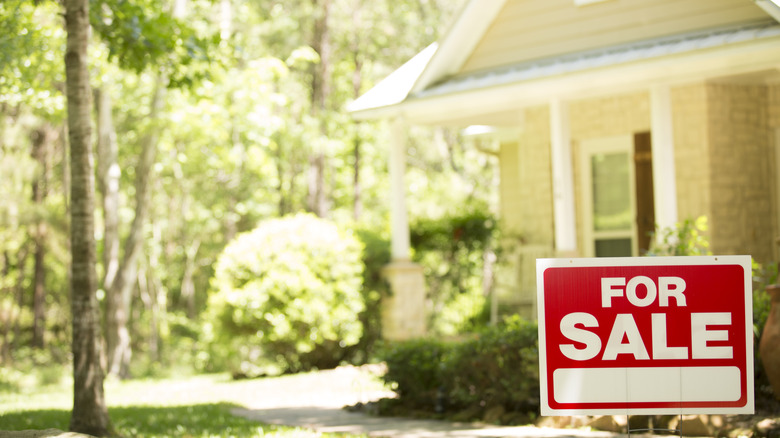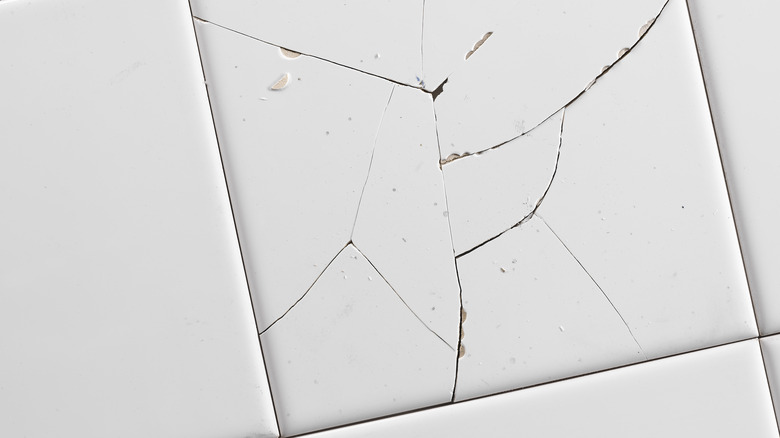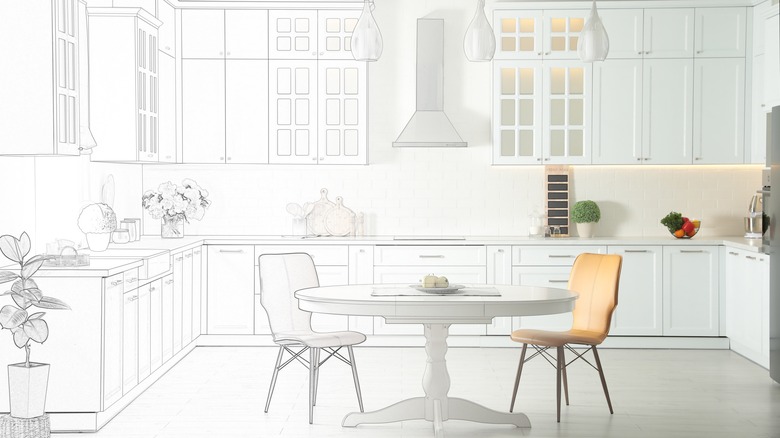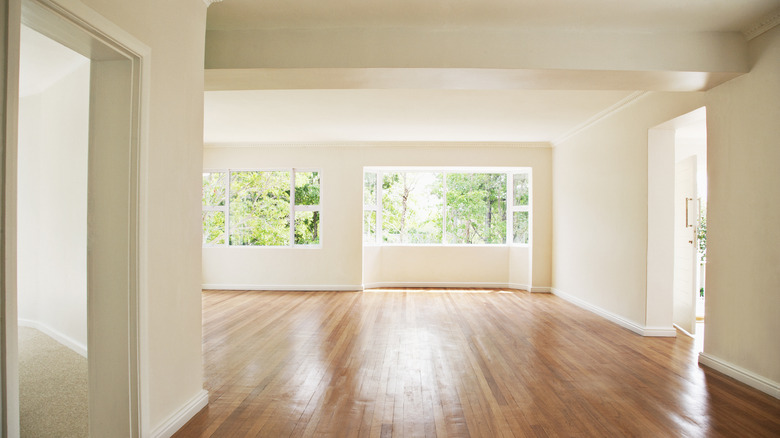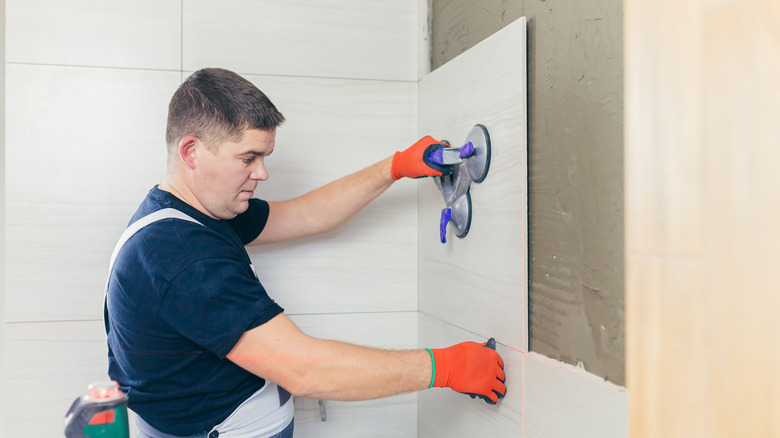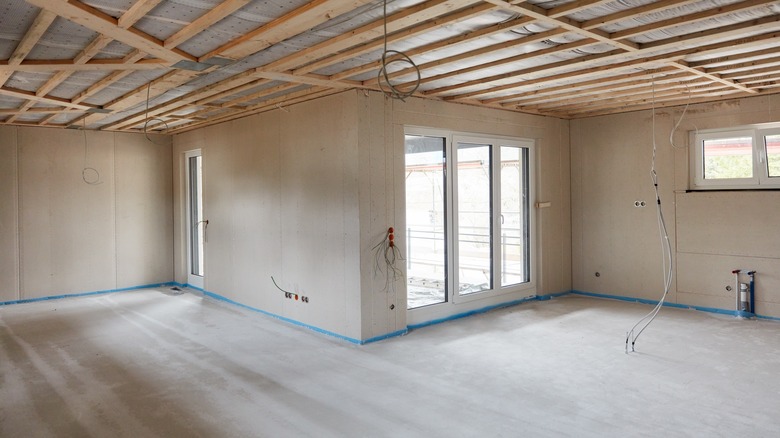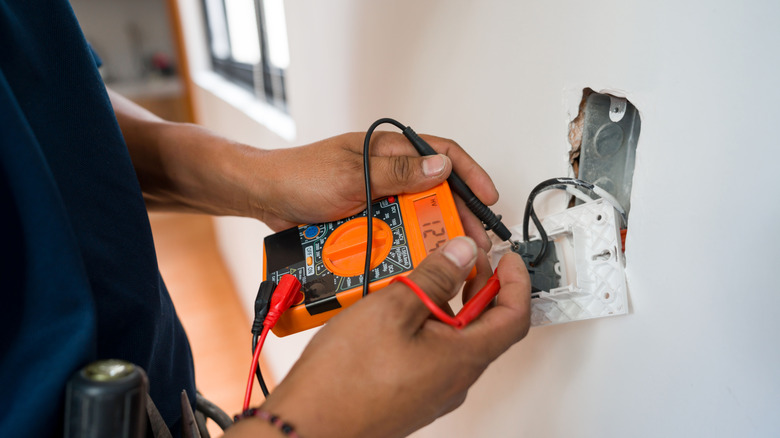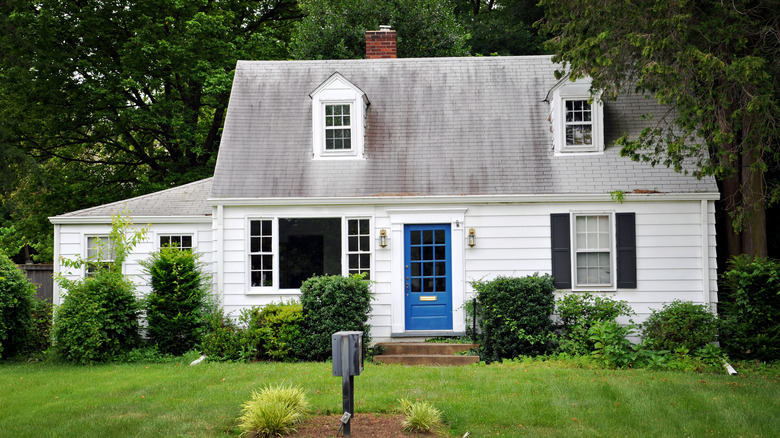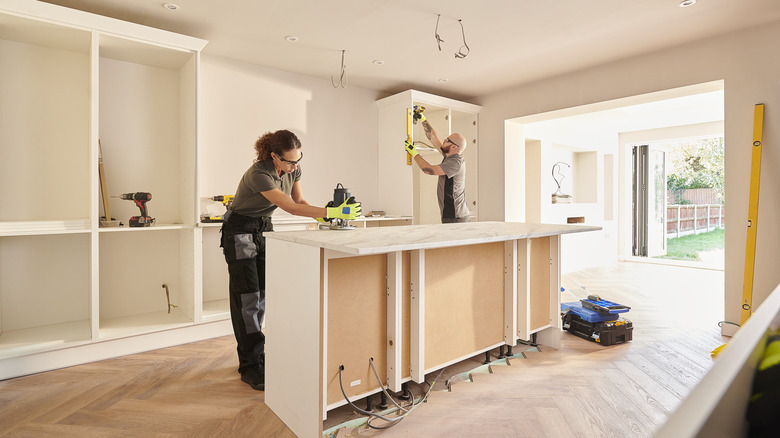Don't Make These Home Renovations If You Plan To Sell Your Home Soon
Selling your home is a natural step in the constant flow of big life decisions. Many individuals and families find that the home that once served their needs perfectly no longer feels in sync with their lifestyle. You might be considering upgrading from a two-bedroom to a three to accommodate new home working requirements or an upcoming addition to the household. Or perhaps you're seeking to downsize after the children have all moved out. A home is a significant financial asset, and the proceeds from the sale will act as a driving force in landing a new property that better serves your needs.
As a result, it's absolutely essential to get the highest sale price possible when listing your home on the market. Often, the process of selling a home begins with a few renovation projects. It's only natural that wear and tear over the years will leave some components of the property a little scruffy. Fixing up a few things around the house will give it that shine that new buyers are looking for, but some renovations aren't worth their cost. Tactics like remodeling the whole kitchen actually tend to leave you worse off financially than when you started. Take care not to fall into this and other renovation traps as you prepare to list your home for sale.
Don't paint in bold color styles
Often, when preparing to sell a house, it's a good idea to think about repainting the walls. Generally speaking, repainting your walls every three to five years is good practice for keeping up with evolving style choices and the overall maintenance of the property. As a result, whether you routinely repaint or not there's a good chance that a fresh coat of paint can quickly add a lot of new depth to your interior spaces.
But this comes with a significant caveat. If you do opt to repaint your home make sure you keep to a neutral color palette rather than selecting bright, bold colors to feature throughout the home. A freshly painted room won't require any further maintenance for buyers unless the color choice is awful or they simply decide to change the color on their own to fit a nuanced decorative vision. In the same way that old paint can take away from the home's aesthetic, so too can bright and loud colors turn potential buyers off. A bright red room might make for a bold entertainment space for some and a blight that will need to be immediately addressed (adding to the financial toll of purchasing the home) for others. Shying away from bold colors when repainting is a must, and if you already live in a home with loud feature walls then repainting should be near the top of your list.
Bite the bullet on cosmetic and vanity flaws
Another area in which restraint will serve you best comes in the form of cosmetic flaws. Cosmetic issues should be expected in every house. Even newly built properties leave something to be desired in their construction, it's just a part of life. Things like scuffed-up floors or even more noticeable imperfections like cracked tile or worn countertops might have you cringing internally as a seller. But the reality is that replacing or fixing these kinds of minor vanity flaws will cost you far more than you'll make it back as a result of the improvement.
An issue with your kitchen countertops or bathroom tile, for instance, likely cannot be solved without ripping out the entire feature in question and replacing the whole thing. You may not be able to source the exact same tile that was used to remodel your bathroom, and even if you could find a perfect match the new section will only serve to highlight the age of the pieces around it. Cosmetic troubles might confound you as you walk around your home and take stock of all the little fixes that could be done. But ignoring them in favor of the big picture is your best approach when trying to maximize the financial value of your home.
Forget about major kitchen overhauls
Changing significant layout features in the kitchen might prove to be a fantastic aesthetic upgrade. Installing a kitchen island, opting for granite or marble countertops, or even retooling your cabinets for a more functional feel can make for an amazing culinary experience in the home. But major kitchen renovations are best done in a space that you intend to live in for the long term. The truth is that everyone's perfect kitchen will be unique so making a major kitchen overhaul a part of your plans is only a good idea in a home you've recently bought or one that you intend to stay in for many more years.
Common wisdom on the subject suggests that a typical major kitchen update might cost roughly $68,000, on average, while returning only about 59% of the investment — or an estimated $40,000. The result is that rebuilding your kitchen to try to drive up interest in the home can make for higher viewership but averages a loss in value of almost $30,000 on the eventual sale price. Small improvements like repainting the cabinets or changing out hardware can improve the look and feel of a kitchen without incurring the same level of expense and ultimate financial loss.
Think carefully about flooring changes
Hardwood floors act as a gigantic draw for those looking to buy a new house. Just about everyone salivates over a beautiful hardwood flooring feature in the living room or entryway. However, this elegance comes at a cost, and changing out existing laminate, old hardwood, or linoleum for a new hardwood flooring centerpiece likely won't reap financial rewards. These are extremely costly to install, and with the importance that many place on hardwood flooring you may not want to do it yourself. The installation then adds to the total cost of the job substantially. Return on investment for new hardwood flooring hovers between 70% and 80%, making it a better choice for a major job than a large-scale kitchen remodel in a head-to-head comparison. However, this will still leave you in the red when it comes to improving the value of your property in the hopes of making a great sale.
The exception may come if you're replacing very old carpeting. Carpet that looks and feels dated can severely reduce interest in your home. Buyers will look at the flooring and immediately think that they need to do something about it if they end up purchasing the property. Others may opt to skip making an offer altogether. Upgrading your floors can swing this balance farther in your favor, but a low-cost option is likely your best bet.
Leave the old appliances in place
Generally, when you sell your home at least some of the appliances will remain. This can lead to a temptation to replace an aging washing machine or oven to sweeten the deal for potential buyers. But the reality is that buyers don't tend to think of aging appliances as a make-or-break component of the buying process. In truth, many buyers will be looking to replace these kinds of features with their own new additions in the coming months or years, so a working dishwasher means that something else can be prioritized in the short term — regardless of its age.
Sinking money into a new appliance won't typically make much, if any difference in your ability to sell the home, and it will cost you money upfront. On the other hand, if the appliances in the home are extremely old — and maybe have required a few rounds of repair work — then buying something new may be a good way to boost the overall appeal of the property. Old and tatty installations can make buyers wary of other issues that may be lurking in the home. If you do opt to purchase something new, don't splurge on a top-of-the-line model. A standard build will do just fine in bringing the home together as a quality package.
Only tackle minor landscaping concerns out front
A major overhaul of the front yard can drastically improve curb appeal — something that has proven to increase a home's perceived value by as much as 11%. But it's easy to overrun the scope of a standard exterior buff-up and venture into major landscaping and outdoor improvement territory. Minor improvements like replacing welcome mats, trimming the hedges, or mulching the flower beds can bring up the visual appeal in a meaningful way. There's no need to dig up bushes, resod the lawn, or lay down new paver walkways.
Major works quickly become costly, and they won't provide any tangible financial returns. Instead, focus on things that are simple, relatively cheap, and produce a big impact. A fresh coat of paint, a newly mowed lawn, or a bit of trimming and edging can go a long way and won't take up much time, energy, or financial resources in comparison. It's important to keep focused on the things that matter the most to buyers. The façade is the first thing they'll see when approaching the home, but it's the interior that provides the living space and can sink a deal.
Definitely don't add a new bathroom
The number of bathrooms a home features can act as a determining factor in the value that a home fetches. However, there are two primary ways that creating a new bathroom in your home can actually reduce its resale value. First of all, additional bathrooms only recover about 50% of the investment put into the work—simply put, they're more expensive to install than the pure financial value they add to the equation, twice as much to be exact. In a purely mathematical approach to selling a home, making this change just doesn't add to the bottom line.
Moreover, the addition of a new bathroom requires renovators to carve out space from somewhere else. It's possible to create an extension of the property's footprint, but this approach is even more costly as it adds foundation work, building new exterior walls, and more to the picture. To introduce a new bathroom, your home will have to lose space somewhere else. This might be in the form of a storage closet, bedroom, or even a part of the communal living space. Shaving off precious square footage from other living quarters and storage features can reduce the effectiveness of the property, making it feel tighter and less inviting. The end result is a home that might lose both resale value and overall interest from potential buyers.
Don't build an addition
Additions are another construction project that should virtually never be attempted on a home that's destined for the market. They're a fabulous option for building out the perfect home for individual needs. Adding on another bedroom or a space for a home office or gym can be a great way to personalize your home. Improving the layout or just adding a bit of breathing room to existing spaces can transform the value the home provides to you, the homeowner engaging in the renovation.
But an addition won't pay off financially if the only reason for making the enlargement is to infuse additional value into the home before listing it for sale. These improvements are best done when moving into a property, or making the decision to stay in a home for many more years to come. Additions are an intimately personal way to transform a home so that it better serves a particular use case or set of needs. No two homeowners will share the same requirements, though, even when considering the exact same property. As a result, an addition might be a nice thing to have in a home for buyers shopping around, but it's typically not going to bring in the same return that the construction cost due to the uniqueness of every buyer's circumstances and 'shopping list.'
Forget the small electrical issues
Quirks are a part of every home. Buyers and sellers alike are sure to run into the reality that every property was built by human workers. Sometimes builders cut corners, and other times changes in technology and materials through the years lead to outdated installations as time goes on. When considering electrical systems in the home, it's important to differentiate between major issues and minor ones. A seemingly useless light switch or less than practical outlets in a room (maybe they're all located at floor level or there's only one in the room) aren't things that sellers should concern themselves with. These are quirks rather than problem areas, and focusing on remedying these types of oddities will only serve to drive down the overall profit from the sale and take up valuable time beforehand.
However, bare, exposed wiring, ungrounded outlets, and other hazards should absolutely be inspected and fixed before launching into the selling process. These types of electrical dangers are things that can severely injure visitors coming to view the home, and they can also significantly detract from interest and value in the property. While cosmetic worries might send interested buyers on a wild goose chase seeking other flaws, major oversights like this will have them tucking tail and hurrying back out the door.
Skip out on bringing old homes up to new code standards
Building codes are a voluminous and often tedious part of construction. Whether its ensuring that beams are reinforced with the correct number of nails through joist hangars, or the windows are correctly hardened against natural disasters that may befall the area, building codes are constantly being revised and updated. This is done so that the best in safety precautions and technology are constantly going into homes that people will rely on. With time, these things improve.
A conscientious seller might look at an old house and think that its construction isn't up to snuff for the modern marketplace. However, structures that were built to code remain grandfathered in, no matter how much regulations may have changed in the interim. This means that renovating specifically to bring older homes up to newer code standards isn't necessary and will only result in costly changes that don't add anything of fiscal value to the property. The exception is in renovations that add something new to the home. A rebuilt pool deck, for instance, will need to take current regulations into consideration, adding the modern, requisite safety barriers around the water feature.
Don't work in half measures
Finally, if you do plan to undertake a renovation project to get the home in tip-top shape before listing it, one factor can't be stressed enough. It's absolutely crucial to ensure that there's enough time and space in the budget and moving target date to complete the project. A halfway completed project (be it a living room modernization or a painting endeavor) will stick out like a sore thumb in the home. Similarly, by deciding to begin an update, make sure you don't skimp on the finishing touches or materials.
Getting cold feet midway through a project or only budgeting for a threadbare installation will send up red flags for any buyer making their way through the home. Potential buyers will be able to easily discern the halfhearted nature of the fix and then likely begin scouring the home for any other flaws that may be lying in wait. A squeaky floor doesn't indicate a poorly sealed window or sloppily installed floor trim, but it certainly suggests a lack of thoroughness that requires a more in-depth examination before an offer should be made. Seeing any project you start through to the finish will ensure that the home looks and feels complete, giving buyers a sense of ease as they visualize themselves living in the property.
